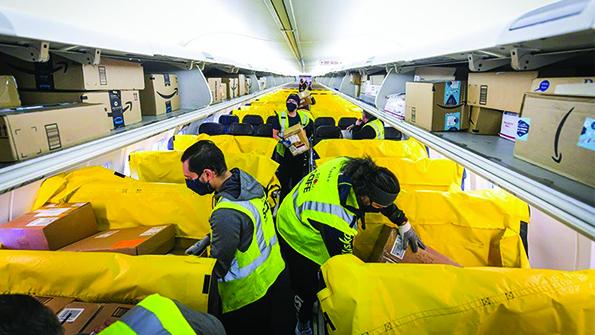
When you’re put in a sink-or-swim situation, you swim. That’s what the pandemic has felt like. First, we gasped and flailed. Then we all started furiously kicking and windmilling our arms at a fast pace. After a couple of months, we caught our breath, donned goggles and switched to rhythmically paced strokes.
A lot of splashing was involved in this transformation, but those who diligently worked on more efficient strokes became faster and will seriously cruise when the water isn’t as choppy.
We’re still in the water, with some winds ahead, so keep swimming, but this survival process that we’ve gone through in 2020 has bred innovation and accelerated progress in our industry.
For instance:
Cargo As passenger traffic decreased and the need for cargo capacity increased, a host of companies created unique ways that airlines could strap cargo onto and in between passenger seats shortly after the pandemic spread around the world. This provided airlines much-needed revenue and helped distribute essential goods. HAECO and Lufthansa Technik were among the first to provide such solutions.
Cabin Look at all of the products and services that entered the market this year to kill pathogens in aircraft cabins—from electrostatic ionization to antimicrobial LED lights to antimicrobial coatings and antibacterial cleaners that can be used on various seat surfaces, including leathers.
Collaboration tools Several MROs started using remote-collaboration technologies to complete inspections and even work with regulators on audits so they didn’t have to come to the site. These tools and accelerated digitalization efforts will provide benefits beyond the pandemic.
Engine programs OEMs used the year to expedite fixing problems in their new engines. Before the pandemic, “the supply chain was bursting at the seams,” says Gijs Gielen, head of aftermarket marketing for Pratt & Whitney. But the slowdown has allowed the supply chain to catch up and the OEM to finish at least 90% of the tech insertions for geared turbofans by year-end. Rolls-Royce has almost caught up on the Trent 1000 changes, as well.
Our industry has taken the time to advance during the pandemic, which sets it up for the recovery. Limited international travel is resuming as airlines and airports trial COVID-19 testing on specific routes so passengers don’t have to quarantine after negative tests. With several vaccines poised to imminently gain regulatory approval, these are hopeful signs for 2021.
What innovations and transformations is your company making? What changes were accelerated this year? I’d love to hear about them ([email protected]). Let’s celebrate the positives.
On our end, we’ve also accelerated our digital efforts this year. Next year, we will deliver more Inside MRO content digitally, which means we’ll provide more webinars, podcasts, photo galleries, articles, videos and data at AviationWeek.com/mro. We will print four fewer issues in 2021, so instead of waiting for us to create and publish one in January—check our website regularly for daily updates—and we’ll return to print in February but keep up the digital efforts, too. In this rapidly changing environment, we’re trying to deliver information to you as fast as we can.
And in the meantime, keep swimming. The finish line isn’t far off.




